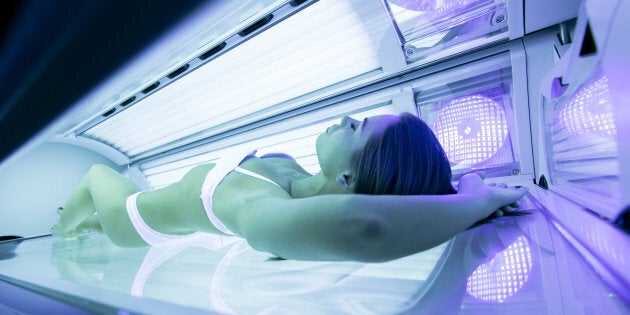
As the days approach their shortest length of the year, over one million Canadians will seek out a different kind of sunlight in the form of a tanning bed. This means of getting some sun has been seen in the past as a way to improve one's mood and self-esteem. The practice also has been touted as a possible route to increase Vitamin D levels, which tend to drop during the winter as a result of less exposure to the sun.
Despite the benefits, public health officials are wary of indoor tanning. This distrust comes as a result of the risks associated with exposure to various ultraviolet rays, commonly known as UVA and UVB. While sunburns are the most common problem, decades of research have revealed these rays also damage the genetic material contained within the cells of the skin.
In this case, however, the culprit isn't genetic.
While we all have repair mechanisms to deal with the damage, they are not always perfect. Normally, the consequences are minor. But if the damaged genetic regions happen to encompass what are known as oncogenes, the end result could be uncontrolled growth and multiplication of cells. This condition is better known as cancer.
The threat of cancer from tanning beds has become an international issue and researchers have worked to identify factors leading to increased risk of tumours. some have been identified such as a lack of the skin pigment known as melanin or the age at which a person begins to tan regularly. In the latter case, people under 25 years of age tend to be at greater risk.
Now, thanks to a group of German researchers, we may have an addition to this list of risk factors. The team identified a possible link between the development of cancer and a biological condition many people suffer. In this case, however, the culprit isn't genetic. It's viral.

The target of this investigation was the papillomavirus, which causes warts. The virus is normally harmless, but research has shown the infection can lead to cancers, such as cervical cancer and, indeed, skin cancer. In the past, researchers have identified a possible link between viral infection, exposure to UVB rays and the onset of skin cancer. However, this had never been examined closely. The German team wanted to find out whether that link was for real.
The group worked with a mouse known to suffer from papillomavirus infections. The animals also had a good genetic repair mechanism against UVB radiation. This made it the perfect model to determine if the virus was involved in UVB cancer development. In essence, if the infected mice ended up with cancer due to tanning, the link would be made.
Not surprisingly, the results showed just that. After about 30 weeks of three-day a week exposure to the same type of UV radiation seen in midsummer or a 20-minute indoor tanning session, only mice infected with the virus began to develop tumours. By 80 weeks of exposure, almost all the mice with the viral infection suffered. In contrast, in uninfected mice, there were no signs of cancer even with the tanning.
This particular experiment may have revealed the link between infection, UVB and cancer. However, the team still couldn't explain how the virus was causing the trouble. That required a deeper look inside the skin cells to find out what exactly was going on.
It may be well worth finding alternative ways to deal with the short and cold wintry days.
The answer was almost too easy. Much like how viruses tend to alter other cellular processes, the papillomavirus was hindering the usually trustworthy genetic repair mechanism. The cells were left unable to counter the development of a cancer state. With continued UVB exposure, the odds simply went in favour of tumour development.
The outcome of this study may have been in mice, but the results might provide a glimpse at what may happen in the human body. When HPV infects the skin causing a wart, little troubles should be expected as the skin isn't in need of any repair. However, with continued exposure to UVB radiation, the potential for problems arise as genetic material suffers from the damaging rays. If the virus finds a way to stop the healing process, as in this study, the individual is left with a higher risk for cancer.
While this study may appear to add another reason to worry about indoor tanning, the results do not suggest people should avoid it at all costs. Instead, as regulatory agencies in Canada and across the world have suggested, tanning should be done in moderation and only by adults. Granted, this new research may put a chill on some people's hopes for that artificial warmth. Yet considering the possible risks, it may be well worth finding alternative ways to deal with the short and cold wintry days.
Follow HuffPost Canada Blogs on Facebook
Also on HuffPost: